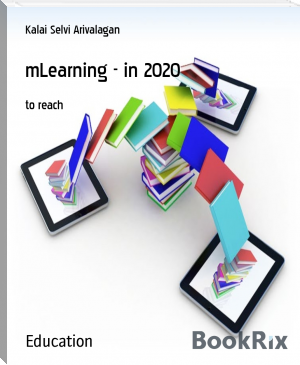INNOVATIONS IN SCIENCE, TECHNOLOGY AND MATHEMATICS EDUCATION IN NIGERIA, Ebele C. Okigbo, Nneka R. Nnorom, Ernest O. Onwukwe [best reads .TXT] 📗

- Author: Ebele C. Okigbo, Nneka R. Nnorom, Ernest O. Onwukwe
Book online «INNOVATIONS IN SCIENCE, TECHNOLOGY AND MATHEMATICS EDUCATION IN NIGERIA, Ebele C. Okigbo, Nneka R. Nnorom, Ernest O. Onwukwe [best reads .TXT] 📗». Author Ebele C. Okigbo, Nneka R. Nnorom, Ernest O. Onwukwe
Using relevant interactions, teachers are expected to embark on the onerous task of providing and enhancing functional learning through critical thinking, inquiry, guided discovery, hands on activities and satisfactory lessons (Hassan, 2006). As Baker (2007) pointed out, unless the students perceive the teacher as initiating satisfactory classroom interactions, their interests, motivations and attainments in the biology curriculum, would be adversely affected.
The students’ classroom learning environment is one of the school factors to be reviewed. Onwuakpa and Akpan (2000) described classroom learning environment of students as an embodiment of the physical, psychological and sociological condition of the class room. The physical condition of the classroom include: age of the classroom building, colour of the classroom, level of available furniture (seats and desks), good ventilation, good lighting, roof/ceiling and smooth floor. The social environment includes: the level of classroom interaction between students and teachers, students and students, students and learning materials, and teacher and teaching aids; and shows how friendly the teacher and students are in the classroom. The psychological environment is an umbrella of the level of speed of teaching, cohesiveness, distractions, interests, motivations, anxieties, confusion and difficulty of classroom learning activities.
The surroundings in which children learn can greatly influence their academic performance and wellbeing in school. The architecture, layout, decorations and facilities of their school, all play a vital role in shaping the learning environment, yet the importance of this particular aspect can often be over looked. Equally, a positive social interaction occasioned by healthy interpersonal relationships among the teachers, students and other personnel of school is a crucial antecedent for teaching and learning. The social environment created in such setting especially the one that exists inside the classroom can go a long way in promoting a conducive environment for teaching and learning with the result that academic achievement of the students’ will be improved. Psychologists are of the opinion that heredity sets the limit while the environment determines whether or not the limit will be attained. Thus, at the moment of conception the blue-print of what a person could be is laid down. The potentialities and qualities he finally possesses depend on the environmental circumstances to which he is exposed.
Empirical studies have shown that teacher classroom interaction have an important impact on students’ outcomes, making it necessary to often investigate teacher classroom interactions. A popular method of investigating what goes on during actual teaching is the use of students’ ratings of the teacher (Wubbels & Levy, 1999). Although teacher appraisals cannot be used solely on this technique, it can be argued that the students are actually the only direct observers and could reasonably evaluate classroom interactions if asked the right questions. Fraser (1994) pointed out that students have a good vantage point to make judgements about classrooms because they have encountered many different learning environments and have spent enough time in classrooms to from accurate impressions. They should at least be able to say what they like or do not like about specific classrooms interactions. It is against this background that the researcher considers it crucial to investigate secondary school biology students’ perception of the classroom interactions of their biology teachers. Also, Offiah and Esiana (2013) observed a low social classroom environment; they opined that a friendly and interactive social classroom environment results to better achievement.
Research Questions
The following research questions guided the study:
To what extent do biology students perceive their teachers as using adequate classroom interactions in their classroom control and discipline?
To what extent are biology students satisfied with their biology teachers’ classroom interactions?
Hypotheses
Two null hypotheses were formulated and tested at 0.05 significant levels.
There is no significance difference between the mean ratings of male and female students’ satisfaction with their biology teachers’ classroom interactions.
There is no significant difference between the mean ratings of high and low ability students’ satisfaction with biology teachers’ classroom interactions.
Method
The study was conducted in Onitsha Education Zone of Anambra state; consisting of Onitsha North, Onitsha South and Ogbaru Local Government Areas. The inhabitants of these areas are mainly artisans, traders, teachers, civil servants, bankers, doctors and other professionals. There are many public and private secondary schools in the area. The population comprised all the 96 biology teachers and SS 2 students of thirty-two (32) public secondary schools in Onitsha Education Zone. Four schools (two male and two female secondary schools) from each local government area in Onitsha Education Zone were selected using stratified random sampling making a total of twelve schools. In each of the twelve schools, students’ past results were collected from the class form teachers. Based on their past biology examination results, 24 high ability and 38 low ability students were selected from the 12 schools totalling seven hundred and forty-four (744). For the purpose of this study, high ability students were defined as the upper 30% of the students based on their scores on the previous examinations, while low ability students were defined as the lower 30%. SS 2 students were chosen because they have been studying biology since their SS1.
Data were collected using a questionnaire titled ‘My Biology Teacher Classroom Interaction (MBTCI). The MBTCI consisted of statements from informal discussions with the learners on their likes and dislikes about their classroom environment and several literature on researches on classroom environments to which the students had to indicate their extent of agreement or disagreement by choosing Very Great Extent (VGE), Great Extent (GE), Low Extent (LE), and Very Low Extent (VLE). The instrument consisted of 16 items separated into sections A and B. Each of the sections has 8 items.
The instrument was validated by two experts in Science Education and an expert in measurement and evaluation. Their comments were used to modify the questionnaire items. The reliability of the instrument was established by administering it to students outside the study area and Cronbach alpha was used to estimate the reliability indices. This was 0.85 for section A and 0.76 for section B. The instrument was thus judged reliable. Mean and Standard deviation were used to answer the research questions by preparing a tally sheet showing the frequency distribution of the various responses weighted on the 4- point rating scale. For decision making, Very Great Extent and Great Extent were merged while Low Extent and Very Low Extent were merged. Mean scores of 2.5(the mid-point of the scale) and above were accepted as indications of Great Extent (GE) of use of classroom interaction; while mean scores below 2.5 were regarded as indications of Low Extent(LE) of use of classroom interaction. The null hypotheses were tested with the t-test statistics at 0.05 level of significance.
Results
Research Question 1: To what extent do biology students perceive their teachers as using classroom interactions in their classroom control and discipline?
Table 1: Mean and standard deviation scores of students ratings of their teachers use of classroom control and discipline
(No of students=718)
Items No
Items on classroom control and discipline
Mean
Standard deviation
Decision
1
The teacher discusses with us on how to behave in class
3.02
1.73
GE
2
The teacher uses eye contact to ensure that we pay attention in class
2.80
1.67
GE
3
The teacher delegates the prefect to punish any of us who comes late
2.66
1.63
GE
4
The teacher gives us a clear set of rules to follow
2.47
1.57
LE
5
To avoid noise- making the teacher calls on students to take turns in talking in class
3.54
1.88
GE
6
The teachers’ scolding makes learning difficult for us
2.77
1.66
GE
7
The teacher makes us busy
2.63
1.62
GE
8
The teacher is aggressive to us
1.83
1.35
LE
Mean of means
2.71
1.63
GE
KEY: Very Great Extent (VGE), Great Extent (GE), Very Low Extent (VLE)Low Extent(LE)
Table 1 shows that the mean scores of items 1to 3 and 5 to 7 were above 2.50, while the standard deviations ranged from 1.2 to 1.88. The mean ratings for items 4 and 8 were less than 2.50 with standard deviations of 1.57 and 1.35 respectively. By this analysis, the students perceived that there was no clear set of rules for them to follow and the teacher is aggressive to them. The mean of means was 2.71 indicating Great Extent. Generally, the students perceived a great extent of classroom control and discipline interactions by their biology teachers.
Research question 2: To what extent is biology students satisfied with their biology teachers’ classroom interactions?
Table 2: Means and standard deviation of students’ satisfaction with their biology teachers’ classroom interaction
(No of students = 718)
Items No
Items on students’ satisfaction
Mean
SD
Decision
9
I am aggressive in biology class
1.88
1.37
US
10
I like attending biology class
2.05
1.43
US
11
I make useful contribution at biology class
2.44
1.56
US
12
I feel bored and inattentive in biology class
3.52
1.87
VS
13
The teacher’s lesson presentation makes me to feel happy in biology classes
2.35
1.53
US
14
The teacher teaches the subject well
2.07
1.43
US
15
The teacher makes me confident that I will do well in biology
2.61
1.61
S
16
The teacher makes me feel like dropping the subject
2.95
1.71
US
Mean of Means
2.48
1.56
US
KEY: Very Satisfied (VS), Satisfied(S), Unsatisfied (US), Very Unsatisfied (VUS).
In table 2, items 9, 10, 11 and 14 had mean ratings below2.50, while items 12, 13, 15 and 16 had mean ratings above 2.50. The standard deviations for these items were between 1.37 and 1.87. This indicates that to a great extent, the students feel worried and aggressive, do not like attending biology classes, are not learning a lot, feel bored, do not feel happy, confident, and feel like dropping biology. The mean of means was 2.48 indicating low extent. Generally there was a low extent of students’ satisfaction with their biology teachers’ classroom interactions.
Null hypotheses
H01: There is no significant difference between the mean rating of male and female students’ satisfaction with their biology teachers’ classroom interactions.
Table 3: t-Test of the mean ratings of male and female students’ satisfaction with their biology teachers’ classroom interactions (P<0.05).
Group
N
Mean
SD
Df
t-cal
t-crit
Decision
Male
352
2.47
1.57
716
0.18
1.96
Accept H01
Female
366
2.49
1.57
In Table 3, the t-calculated value is 0.18 while the t-critical value is 1.96 at 0.05 level of significance with 716 degrees of freedom. By this analysis, the t-calculated is less than the t-critical hence the non-rejection of the hypothesis. Therefore, there is no significant difference in the mean rating of male and female students’ satisfaction with their biology teachers’ classroom interactions.
H02: There is no significance difference between the mean ratings of high and low ability students’ satisfaction with biology teachers’ classroom interactions.
Table 4: t-Test comparisons of the mean ratings of high and low ability students on their biology teachers’ classroom interactions (P<0.05).
Group
No students
Mean
SD
Df
t-cal
t-rit
Decision
High ability students
273
2.55
1.59
716
1.45
1.96
Accept H 02
Low ability students
445
2.41
1.55
Table 4 shows that t-cal is 1.45. This value is less than the t-critical value of 1.96 at 0.05 level of significance (dff=716). This led the researcher to accept the null hypothesis that stated that there is no significant difference between the mean responses of high and low ability students on their biology teachers’ classroom interactions.
Discussion
In the students’ understanding, their biology teachers to a great extent, used classroom interactions in their classroom control and discipline. Specifically, the students were of the opinions that their biology teachers discussed with them how to behave in the class, used eye contact to ensure that students paid attention in the class, delegated the prefect to punish any student that comes late to class. Besides, to avoid noise-making, the teachers called on students to take turns in talking in class, keeps the students busy, and were not aggressive to students. By so doing, the teachers are likely to have devolved some responsibilities in classroom management. Fisher, Henderson and Fraser (1995) also found that Malaysian students perceived their teachers as using high levels of classroom interactions in classroom control.
A point worthy of mention is that of the teacher calling on students to take turns in talking during lessons to avoid noise-making. If care is not taken, because the teacher called out students to contribute, turn taking might become rigidly controlled in favour of high ability students. This is against the principles of the effective science instruction. As Alexander (2006) had noted, if turn taking is controlled, and our aim





Comments (0)